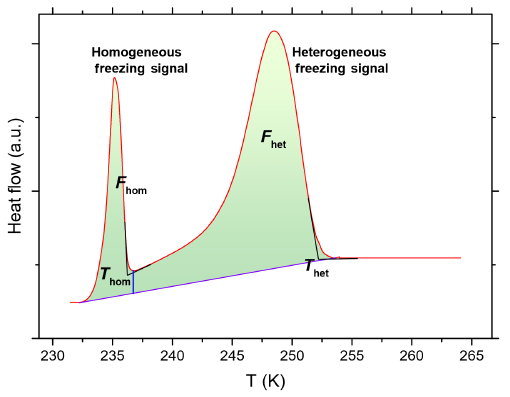Aerosols acting as ice nucleating particles
Background
The formation of ice in mixed-phase clouds occurs in the presence of aerosol particles with the ability to nucleate ice on their surface (heterogeneous freezing). These ice-nucleating particles (INPs) represent a small fraction of particles in an atmospheric aerosol. One main particle type which acts as INPs are mineral dusts such as clay minerals, feldspars, and quartz. Different factors influence the ice nucleation ability of such mineral dust particles. Besides the obvious factor of temperature, semivolatile substances that accumulate on the particle surface or electric fields and charges carried by the particles or by cloud droplets may increase or reduce the ice nucleation activity. Furthermore, the freezing mode plays an important role.
What are the mechanisms of ice nucleation?
Ice in clouds can form homogeneously at temperatures below approximately 237 K or heterogeneously at any temperature between 237 and 273 K. While homogeneous ice nucleation occurs in the volume of water or solution droplets, the surfaces provided by INPs are involved in heterogeneous nucleation. Different mechanisms of heterogeneous ice nucleation are traditionally distinguished: (1) immersion freezing, when nucleation occurs on an INP that is immersed in the supercooled droplet; (2) condensation freezing, when ice nucleates while an aerosol particle activates to a cloud droplet; (3) contact freezing, when an INP collides with a supercooled droplet; (4) deposition nucleation, when water vapor is converted to ice on a solid substrate. While the mechanisms (1) – (3) involve the presence of liquid water or an aqueous solution, the fourth mechanism is considered to occur in the absence of a liquid phase. This view was recently questioned by one of us: Claudia Marcolli pointed out that below water saturation water condensed in narrow pores present in solid aerosol particles may freeze and grow out of the pores when the pores are wide enough to host the critical ice embryo. This pore condensation and freezing (PCF) mechanism is likely to be the relevant nucleation mode below water saturation (external page Marcolli, 2014).
Ice nucleation on mineral dusts
One focus of our research is ice nucleation on mineral dusts:
Claudia Marcolli showed that the ice nucleation activity of Arizona Test Dust (ATD) can be described within the framework of classical nucleation theory (CNT) assuming a probability density function of active sites (external page Marcolli et al., 2007).
Valeria Pinti investigated the clay minerals montmorillonite, kaolinite, and illite and found strong variability in ice nucleation activities between samples of a mineral depending on its source and pretreatment (external page Pinti et al., 2012).
Lukas Kaufmann investigated to what degree the mineralogy determines the ice nucleation activity of ground collected mineral dusts (external page Kaufmann et al., 2016). Moreover, he analyzed nucleation rates of a mineral dust collected in the Hoggar Mountains (Morocco, external page Kaufmann et al., 2017).
In recent projects, we focused on the effects of solutes on the ice nucleation properties of mineral dust particles. The spectrum of minerals we are interested in covers feldspars with special focus on the K-feldspar microcline, clay minerals and quartz. Anand Kumar showed that solutes containing ammonia or ammonium ions lead to a significant increase of ice nucleation temperatures of microcline (external page Kumar et al., 2018).
In an ongoing study, Kristian Klumpp extends the range of solutes to organic and bioorganic solutes.
Differential scanning calorimetry on water-in-oil emulsions
To investigate ice nucleation we prepare suspensions of the mineral of interest in water or an aqueous solution and emulsify these suspensions in mineral oil in the presence of a surfactant. The emulsion samples are frozen in a differential scanning calorimeter (DSC). With a DSC one can monitor the heat flow that leaves or enters the samples as we cool it down, for example when it comes to heat release due to crystallization or in our case freezing.
The figure below is taken from external page Kumar et al. (2018) and shows a typical DSC thermogram with a heterogeneous freezing signal at warmer temperature due to immersion freezing on microcline and a freezing peak at colder temperature when droplets without an INP freeze homogeneously.
